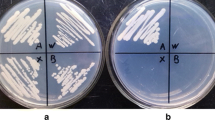Abstract
Plasmids containing the inosine monophosphate dehydrogenase gene CaIMH3 from Candida albicans strain ATCC 32354 transform their host to resistance against mycophenolic acid (MPA). The transformants maintain the plasmids at a high copy number (20–40 per cell) and express the CaIMH3 gene at very high levels relative to untransformed controls. The plasmid copy number can be controlled by the concentration of MPA in the media. The transformation procedure is reproducible and the efficiency of transformation is high, up to 15,000 per microgram. Unrearranged plasmids are readily recovered by transforming total DNA from transformants back into Escherichia coli. C. albicans genes cloned into the plasmid are expressed at elevated levels relative to untransformed controls. A derivative vector containing the CaMAL2 promoter and termination sequences expresses the CaERG11 ORF at high levels and confers moderate resistance to fluconazole. These shuttle vectors should facilitate global genomics approaches in C. albicans that have been hampered by its diploid genome.







Similar content being viewed by others
References
Backen AC, Broadbent ID, Fetherston RW, Rosamond JD, Schnell NF, Stark MJ (2000) Evaluation of the CaMAL2 promoter for regulated expression of genes in Candida albicans. Yeast 16:1121–1129
Beckerman J, Chibana H, Turner J, Magee PT (2001) Single-copy IMH3 allele is sufficient to confer resistance to mycophenolic acid in Candida albicans and to mediate transformation of clinical Candida species. Infect Immun 69:108–114
Beggs JD (1978) Transformation of yeast by a replicating hybrid plasmid. Nature 275:104–109
Berman J, Sudbery PE (2002) Candida albicans: a molecular revolution built on lessons from budding yeast. Nat Rev Genet 3:918–930
Broach JR, Strathern JN, Hicks JB (1979) Transformation in yeast: development of a hybrid cloning vector and isolation of the CAN1 gene. Gene 8:121–133
Brown DH Jr, Slobodkin IV, Kumamoto CA (1996) Stable transformation and regulated expression of an inducible reporter construct in Candida albicans using restriction enzyme-mediated integration. Mol Gen Genet 251:75–80
Cannon RD, Jenkinson HF, Shepherd MG (1992) Cloning and expression of Candida albicans ADE2 and proteinase genes on a replicative plasmid in C. albicans and in Saccharomyces cerevisiae. Mol Genet Genomics 235:453–457
Castano I, et al (2003) Tn7-based genome-wide random insertional mutagenesis of Candida glabrata. Genome Res 13:905–915
De Backer MD, Magee PT, Pla J (2000) Recent developments in molecular genetics of Candida albicans. Annu Rev Microbiol 54:463–498
Geber A, Williamson PR, Rex JH, Sweeney EC, Bennett JE (1992) Cloning and characterization of a Candida albicans maltase gene involved in sucrose utilization. J Bacteriol 174:6992–6996
Horrocks P, Lanzer M (1999) Differences in nucleosome organization over episomally located plasmids coincides with aberrant promoter activity in P. falciparum. Parasitol Int 48:55–61
Kohler GA, White TC, Agabian N (1997) Overexpression of a cloned IMP dehydrogenase gene of Candida albicans confers resistance to the specific inhibitor mycophenolic acid. J Bacteriol 179:2331–2338
Kontoyiannis DP, Sagar N, Hirschi KD (1999) Overexpression of Erg11p by the regulatable GAL1 promoter confers fluconazole resistance in Saccharomyces cerevisiae. Antimicrob Agents Chemother 43:2798–2800
Kurtz MB, Cortelyou MW, Miller SM, Lai M, Kirsch DR (1987) Development of autonomously replicating plasmids for Candida albicans. Mol Cell Biol 7:209–217
Lopez-Ribot JL, et al (1998) Distinct patterns of gene expression associated with development of fluconazole resistance in serial Candida albicans isolates from human immunodeficiency virus-infected patients with oropharyngeal candidiasis. Antimicrob Agents Chemother 42:2932–2937
Maebashi K, et al (2001) Mechanisms of fluconazole resistance in Candida albicans isolates from Japanese AIDS patients. J Antimicrob Chemother 47:527–536
Mann BJ, Akins RA, Lambowitz AM, Metzenberg RL (1988) The structural gene for a phosphorus-repressible phosphate permease in Neurospora crassa can complement a mutation in positive regulatory gene nuc-1. Mol Cell Biol 8:1376–1379
Pla J, Perez-Diaz RM, Navarro-Garcia F, Sanchez M, Nombela C (1995) Cloning of the Candida albicans HIS1 gene by direct complementation of a C. albicans histidine auxotroph using an improved double-ARS shuttle vector. Gene 165:115–120
Rine J (1991) Gene overexpression in studies of Saccharomyces cerevisiae. Methods Enzymol 194:239–251
Rustchenko EP, Curran TM, Sherman F (1993) Variations in the number of ribosomal DNA units in morphological mutants and normal strains of Candida albicans and in normal strains of Saccharomyces cerevisiae. J Bacteriol 175:7189–7199
Sambrook J, Fritsch EF, Maniatis T (1989) Molecular cloning: a laboratory manual. Cold Spring Harbor Laboratory, Cold Spring Harbor, N.Y.
Sanchez-Martinez C, Perez-Martin J (2002) Site-specific targeting of exogenous DNA into the genome of Candida albicans using the FLP recombinase. Mol Genet Genomics 268:418–424
Staib P, et al (1999) Host-induced, stage-specific virulence gene activation in Candida albicans during infection. Mol Microbiol 32:533–546
Staib P, Michel S, Kohler G, Morschhauser J (2000) A molecular genetic system for the pathogenic yeast Candida dubliniensis. Gene 242:393–398
Struhl K, Stinchcomb DT, Scherer S, Davis RW (1979) High-frequency transformation of yeast: autonomous replication of hybrid DNA molecules. Proc Natl Acad Sci USA 76:1035–1039
Versaw WK, Metzenberg RL (1996) Activator-independent gene expression in Neurospora crassa. Genetics 142:417–423
White TC (1997) Increased mRNA levels of ERG16, CDR, and MDR1 correlate with increases in azole resistance in Candida albicans isolates from a patient infected with human immunodeficiency virus. Antimicrob Agents Chemother 41:1482–1487
White TC, Holleman S, Dy F, Mirels LF, Stevens DA (2002) Resistance mechanisms in clinical isolates of Candida albicans. Antimicrob Agents Chemother 46:1704–1713
Wirsching S, Michel S, Kohler G, Morschhauser J (2000) Activation of the multiple drug resistance gene MDR1 in fluconazole-resistant, clinical Candida albicans strains is caused by mutations in a trans-regulatory factor (in process citation). J Bacteriol 182:400–404
Author information
Authors and Affiliations
Additional information
Communicated by J. Heitman
Rights and permissions
About this article
Cite this article
Du, W., Coaker, M., Sobel, J.D. et al. Shuttle vectors for Candida albicans: control of plasmid copy number and elevated expression of cloned genes. Curr Genet 45, 390–398 (2004). https://doi.org/10.1007/s00294-004-0499-3
Received:
Revised:
Accepted:
Published:
Issue Date:
DOI: https://doi.org/10.1007/s00294-004-0499-3




